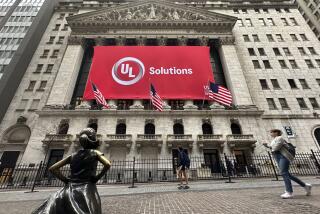Who should get mortgage aid?
Faced with the home mortgage debacle that underlies one of the most dangerous economic crises since the Great Depression, Congress and the administration have been all but paralyzed by two questions: Who deserves to be helped? And how far should the government go to set matters aright?
Although the Federal Reserve moved dramatically to prevent catastrophe among Wall Street’s major financial houses, Congress and the Bush administration have taken only small steps to deal with the root problem: the financial tsunami in the housing market set off by defaults on sub-prime mortgages.
But all that may be about to change.
The House and Senate are beginning to consider proposals for federal intervention on a massive scale. In effect, the government would take over many of the risks now borne by lenders, borrowers and investors -- offering to revamp and then guarantee about 1 million troubled mortgages in an effort to shore up plunging home prices.
The change would come in two stages. The first would be the likely passage Tuesday of a modest bipartisan housing aid package in the Senate.
Next would come action over a period of months on measures to guarantee $300 billion or more in revamped mortgages.
The two measures, advanced by Rep. Barney Frank (D-Mass) and Sen. Christopher J. Dodd (D-Conn.), are likely to attract opposition from President Bush, who has shown a deep reluctance to step into the current housing crisis or even say much about it.
--
Not a revolutionary step
The proposals also are likely to raise the ire of mortgage industry lobbyists and investors in mortgage-backed securities, who want any effort to ease the crisis to be voluntary and small scale.
Nevertheless, calls for passage of one of the measures or something similarly sweeping are growing increasingly insistent as lawmakers and many economists conclude that something must be done to end the real estate price plunge quickly if the economy is to right itself.
And, contrary to what many Americans may think, government action on such a dramatic scale would not be new or even all that unusual. Washington has taken similar-size steps during economic crises of the past.
Repeatedly in the nation’s history, from the savings and loan scandal of the 1980s to the Depression of the 1930s and the financial panics of the 18th and 19th centuries, Washington has stepped in when large numbers of ordinary citizens were threatened with financial devastation.
“There’s been a long tradition -- dating back well before the New Deal -- of saving the family home or the family farm,” said Michele Landis Dauber, a Stanford University professor of law and sociology and author of “The Sympathetic State.”
In almost every instance, action came only after long, agonized debate, particularly over the question of whether the beneficiaries of government action were in trouble through no fault of their own.
And in almost every instance, a simple calculation tipped the balance in favor of action: Although some who were undeserving might end up being helped along the way, the benefit to society as a whole was simply too substantial to ignore.
“In both the United States and Britain, policymakers have long sought to distinguish between the so-called deserving and undeserving,” said Harvard University economic historian David A. Moss, author of “When All Else Fails: Government as the Ultimate Risk Manager.”
But in practice, he added, “it’s often difficult to distinguish reliably between the two. By pushing too hard on this distinction, policymakers run the risk of punishing everyone, rather than just the supposed bad apples.
“As James Madison once observed in another context, ‘Some degree of abuse is inseparable from the proper use of every thing.’ ”
Such pragmatism has been apparent in the Federal Reserve’s recent efforts to calm rattled financial markets.
The central bank assumed the risk of almost $30 billion of troubled securities from Bear Stearns Cos. and provided similar-size loans last month to grease the skids for a takeover of the crippled investment bank by JPMorgan Chase & Co.
In the process, it probably helped wealthy and arguably undeserving players such as Bear’s creditors and JPMorgan. But Fed officials said the price of not acting would have been even higher.
“If you want to say we bailed out the market in general, I guess that’s true,” Fed Chairman Ben S. Bernanke told a congressional committee last week. “But we felt that was necessary in the interest of the American economy.”
A similar calculation led Washington to intervene in the 1980s savings and loan crisis.
The S&L; industry had gone on a lending rampage, but most of its bets had gone bad. The government seized the assets of 1,000 S&Ls;, sold off half a trillion dollars’ worth of property and spent $124 billion of taxpayer money paying deposit insurance to the institutions’ customers, as well as aiding those few institutions that were considered salvageable.
Many depositors were ordinary people whose life savings were threatened. But others were speculators who simply made bad investment decisions -- often with the assistance of S&L; executives.
The government set aside the question of who was deserving of aid, deciding that leaving it to market forces to work through the problem would have hurt many innocent savers and been a long-term drag on the economy.
With President Franklin D. Roosevelt, that pragmatism was apparent in one of the earliest New Deal agencies, the Home Owners Loan Corp., or HOLC.
Many Americans had speculated in real estate during the 1920s by taking out short-term bank loans and using the houses they purchased as collateral. Unlike today’s mortgages that allow homeowners to build a stake in their properties, these loans gave borrowers no equity until fully paid off.
As a result, when the housing market and the economy plunged in the 1930s, millions of people lost their homes and the banks took possession.
From 1933 to 1936, the HOLC refinanced the loans of about 1 million threatened families, deserving or not. The agency bailed out many of the banks that had made the original loans as well.
By the time the HOLC finally shut in the 1960s, it had not only paid off its bills but returned a small profit to the federal government.
During the late 18th and 19th centuries, Congress passed four major bankruptcy laws in the wake of financial panics. In each case, the measure released debtors -- deserving or otherwise -- from some of their obligations so they could get back on their feet and become productive members of society again.
In the 1790s, the newly formed federal government finally decided to pay off most of the debts accumulated by the states during the Revolutionary War, despite complaints that speculators in war bonds would benefit.
Distasteful as many found it, paying off the debts was deemed crucial to establishing the new government’s credit at home and abroad.
A similar decision-making process appears to be underway in the current housing crisis.
Many of those who bought or refinanced their homes with sub-prime loans were victims of overzealous loan brokers paid on commission. But many others knowingly took out mortgages they couldn’t afford, betting that home prices would keep rising and that they could easily refinance.
Whether all these borrowers are deserving or not, political leaders are being forced by events to take increasingly pragmatic approaches to the crisis at hand.
--
Pressure for action
Across the political spectrum, the consensus is that Washington has done little to help ordinary Americans affected by the entwined housing and financial crises.
“If you take out the Federal Reserve and a couple of other things, I don’t see government action of much real consequence so far,” said David C. John, a senior fellow at the conservative Heritage Foundation.
“We haven’t done much yet,” agreed Rep. Frank, the liberal chairman of the House Financial Services Committee.
But pressured by the Fed’s aid to financial players, the demands of economically strapped voters and the sense that key lawmakers may have come up with a way to parry the deserving/undeserving distinction, Congress is about to take up proposals that could greatly expand the scope of federal action.
“When the Federal Reserve stepped in to staunch some bleeding on Wall Street, we figured it is time to staunch some bleeding in the housing market, which is hemorrhaging daily all over this country,” said Sen. Richard C. Shelby (R-Ala.).
Under similar proposals by Frank and Dodd, Washington would empower another New Deal-era agency, the Federal Housing Administration, to run a new mortgage guarantee program. Dodd is chairman of the Senate Banking Committee.
To participate, the lender would have to cut the principal of a troubled mortgage to 85% of a home’s current, diminished market value. The FHA would take 5% of the new, lower amount as a fee. Homeowners would get the remaining 10% as equity to give them a stake in paying off the renegotiated mortgage.
Borrowers would have to prove that they had the financial wherewithal to keep up with the now-lower monthly mortgage payments. Those who couldn’t prove they could pay would be ineligible for the program. If borrowers failed to pay the new, smaller mortgage, Washington would do so.
There were hints last week that by making the proposed program voluntary, having the government guarantee but not actually buy up houses or mortgages, and by slapping requirements on both lenders and borrowers, the proposal could fly politically.
That hardly means who’s deserving and who’s not is no longer an issue. Conservatives such as Rep. Jeb Hensarling (R-Texas) declared they would fight the Frank and Dodd plans.
“If you look around at who the innocent parties are,” Hensarling said, “the American taxpayers are innocent.”
Frank’s response? “I want to help the least undeserving people around.”
--






